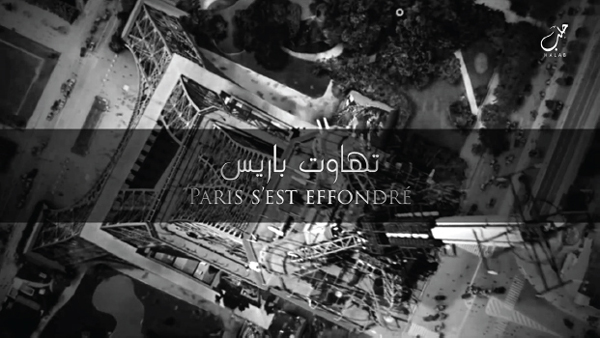
ISIS IN EUROPE, NORTH AMERICA, AND AUSTRALIA

After the American invasion of Iraq in 2003, it quickly became apparent that French citizens were participating in the fight against the US forces as members of Al-Qaeda in Iraq (AQI). In 2003–2004 alone, the French intelligence service arrested 117 Frenchmen for activities associated with joining the Iraq insurgency.554 The pathway from France to Iraq was known as the French Network. It was a group of likeminded activists, adventurers, and fanatics who joined al-Qaeda’s call to defeat America in the center of historic Islam. Three French citizens of this network were Abdelhalim Badjoudj, Redouane el-Hakimand, and Tarek Ouinis. Badjoudj was killed as a suicide bomber in an October 2004 attack where he drove and detonated an SVBIED that injured two American soldiers and two Iraqi police officers. Hakimand was killed by an airstrike in Fallujah in 2004 while fighting as an insurgent, and Ouinis was killed in a firefight with US troops in the Sunni Triangle.555 Numerous French fighters served in leadership and combat roles in AQI and those that remained past 2011 became members of ISIS. As of 2016, as many as 1,700 members of ISIS are French citizens.
ISIS understood the power of its call for Hijrah, emigration to an Islamic land, and Jamaa, gathering together to work and live in prayer. They also know how to manipulate the minds of the Europeans to reject their lives in the unholy land of the Crusaders, and to come live as an Islamic knight in a land made up solely of the best Muslims. They could be given a wife, take whatever riches they could, and kill with impunity like Rambo.
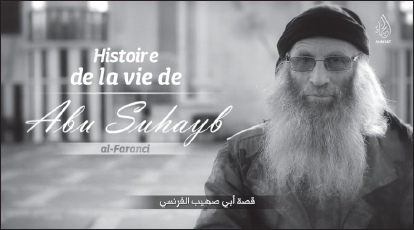
French fighter “Abu Suhayb al-Faranci” is profiled in a highly polished tribute by al-Hayat.
At the beheading of Peter Kassig and of the eighteen Syrian pilots, two French citizens were identified in connection with the decapitations. One was Maxime Hauchard; the second was identified as Michael Dos Santos.556 Just as the British subject Jihadi John decapitated the former US Army Ranger Kassig, the two Frenchmen decapitated two of the eighteen Syrian captives. Twenty French citizens from the French town of Lunel have left for Syria; two were killed in combat fighting for ISIS, identified as Karim and Hamza.557
This appealed to many. However, those who could not make it to the jihad zone were encouraged to stay in France, and to mentally and physically alienate themselves from French society. They were to make symbolic attacks against French citizens wherever possible. France is an attractive target for ISIS due to its international appeal, and because it represents everything jihadists hate the most.
Mohammed Merah murdered seven people in southwest France in 2012 by conducting a motorcycle “run and gun” attack across the city of Toulouse. Riding a stolen Yamaha 500CC T-MAX motorcycle, he rode up to his victims and gunned them down. He shot and killed a French Muslim paratrooper, then killed two more Muslim French soldiers. He then attacked the Ozar Hatorah Jewish day school and murdered four, including Jewish children. Merah was said to have radicalized in prison and traveled to Pakistan and Afghanistan twice before carrying out this mission. Merah was found holed up in an apartment, armed with a fully automatic AK-47, a Uzi submachine gun, and six pistols. Explosives were found in his brother’s car. After a thirty-six-hour siege where he sprayed the French RAID SWAT teams with automatic weapons fire, he was killed with a sniper bullet to the head.558
THE PARIS MASSACRE: ISIS DECLARES WAR ON FRANCE
On November 13, 2015, three teams of ISIS suicide bombers and gunmen conducted multiple, almost-simultaneous attacks throughout northern and eastern Paris. They killed 131 people and wounded 368 others. The attacks consisted of mass shootings, suicide bombings, and a suicide hostage barricade. The attacks started at 9:20 p.m., with two suicide bombers exploded at the Stade de France Soccer stadium.
A second team began running-gun attacks on the Rue Bichat, the Rue de la Fontaine-au-Roi, and the Rue de Charonne, and culminated with a suicide bombing at a restaurant on Boulevard Voltaire. At almost the same time, a third team of four terrorists wearing suicide vests entered the Bataclan theatre from the rear and began systematically shooting as many hostages as they could find.559 French counterterrorism police prepared for a hostage barricade, but by midnight realized that the terrorists were killing hostages, and forced a dynamic entry and engaged the terrorists in a massive gun battle. The terrorists were killed when their bomb belts exploded or were shot dead by police. The siege ended at 1:00 a.m.560
The attack was reminiscent of the November 2008 Mumbai attacks that killed 162 people, where the Lashkar-e-Taiba teams hit multiple civilian targets with overwhelming firepower and suicide bombings almost simultaneously. The element of surprise at multiple locations provided attackers the ability to carry out the attacks without having to worry about police having enough resources to stop them early. Whereas the Mumbai attack was designed to last longer than the initial attack, the Paris aggressors calculated their attacks to achieve the maximum number of casualties as quickly as possible. This proved to be a better strategy than the one used by the Mumbai attackers, who faced an unprepared adversary; Paris is home to some of the world’s best counterterrorism forces, and their immediate intervention had to be taken into account.
THE PARIS MASSACRE ATTACKS
The Stade de France Suicide Bomb Team
Bilal Hadfi, a 20-year-old French citizen who’d been living in Belgium, tried to gain entry to the Stade de France but self-detonated his explosive device nearby upon being turned away. He was supposed to be one of the more experienced attackers, as he fought with ISIS in Syria for over a year. Before the attacks, he posted pro-jihadist messages on the Internet and had communication with ISIS in Libya. Belgian officials received intelligence that he had gone to fight in Syria, but were unaware he had returned to Europe.561

“Stade De France Group
Left- Ukashah al-Iraqi aka M al-Mahmod; Middle- Bilal Hadfi aka Abu Mujahid al-Baljiki; Right- Ahmad al-Muhammad aka Ali Al-Iraqi”
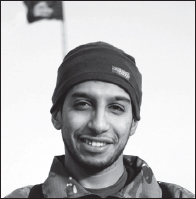
Paris attack cell leader Belgian Abdelhamid Abaaoud featured in Dabiq magazine under his nom de guerre, Abu Umar Al-Baijiki.
The second suicide bomber, M. al-Mahmod, possibly a cover name, had entered the EU with Syrian refugees via the Greek island of Leros on October 3, 2015. He may have been infiltrated to central Europe by Abdelhamid Abaaoud, the cell leader.562 Another ersatz refugee, Ahmad al-Mohammad, possibly an alias, was also registered on Leros in October upon his arrival by boat from Turkey. Fingerprints from that “refugee” also match the attacker’s. It’s possible that al-Mohammad’s passport belonged to a dead Syrian soldier whose identity was stolen upon his death. ISIS and al-Qaeda have employed this kind of document exploitation in the Middle East and North Africa on several occasions in the past.563
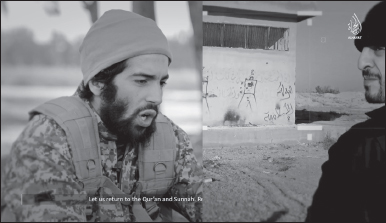
Left - Chakib Akrouh aka Dhul Qarnayn al-Baljiki
Right - Brahim Abdesalam aka Abul Qa’qa’ al-Baljiki
Mobile Suicide Attack “Run and Gun” Team: Bar and Restaurant Attacks
Brahim Abdeslam, a thirty-one year-old French member of the Molenbeek terror cell living in Belgium, carried out the shootings in the 10th and 11th arrondissements. Shortly afterwards, he blew himself up at the Comptoir Voltaire restaurant on the boulevard Voltaire.564 A second suicide bomber remains unidentified. The gunman for the attack was suspected to be the terrorist cell leader Abdelhamid Abaaoud, who drove the suicide bombers to their destinations.565
Bataclan Theater Suicide Hostage Barricade566
Three ISIS terrorists attacked the Bataclan theatre using AKM rifles and wearing suicide explosive vests and, once inside, took hostages. A concert was happening at the time. Samy Amimour, a twenty-eight year-old from Paris, was already wanted on terrorism-related charges and had fought in Yemen as a jihadist. Omar Ismail Mostefai, a twenty-nine year-old from the Parisian suburbs, was also wanted on terrorism charges, and had traveled to Syria in 2013 to fight with ISIS. After the attack Mostefai would be identified by his severed finger.567 The third Bataclan attacker was Foued Mohamed-Aggad, a twenty-three-year-old from Strasbourg, who travelled to Syria in 2013 to join ISIS.

Target Bataclan
Left - Fouad Mohamed Fuad Aggad aka Abu Fu’ad al-Faranasi; Middle - Ismail Omar Mostefai aka Abu Rayyan al-Faranasi; Right - Samy Amimour aka Abu Qital al-Faranasi
Rescue operations resulted in the deaths of all three attackers. One was killed in the initial police assault on the building before the standoff occurred. The other two were killed by their explosive belts once law enforcement made entry. One of them was killed when his suicide vest exploded when gunfire from law enforcement rifle struck him.
ATTACK CASUALTIES
• Locations around the Stade de France (1 killed)
• Le Carillon bar and Le Petit Cambodge restaurant (15 killed)
• Casa Nostra pizzeria (5 killed)
• La Belle Equipe bistro (19 killed)
• Le Bataclan concert hall (91 killed)
ST. DENIS SAFEHOUSE RAID
As planned, the terrorist cell leader Abdelhamid Abaaoud survived the raid on the Paris streets and went to a safehouse at 8 Rue de Corbillion in the St. Denis area of the city. French intelligence and police had started observing the residences of people they suspected in the attacks. One surveillance team saw a man they believed to be Abaaoud enter an apartment block nearby. Abaaoud had been on the run from a massive manhunt that was carried out throughout all of France for four days. A large contingent of SWAT officers from both the French National Gendarme’s Recherece, Assistance, Intervention et Deterrence (RAID) team—the equivalent of the FBI hostage rescue team—and the City of Paris’s Research and Intervention Brigade (Brigade de Recherche et d’Intervention) surrounded the building. Snipers watched the apartment suspected of being the bomb factory. They observed two men and one woman inside. The men were wearing suicide bomb vests and carrying AK rifles. At 4:20 a.m., the RAID assault teams attempted to make entry, leading with an assault dog. An explosive breach failed because the terrorists had reinforced the door. Immediately, Abaaoud opened fire with a fusillade of automatic weapons fire, killing the police dog and wounding several RAID officers. The snipers had to switch from precision-aimed shots to bursts of full automatic fire to suppress the shooters. The woman terrorist, Hasna Aït Boulahcen, a relative of Abaaoud, tried to lure the RAID team to make a second entry, claiming she was a hostage. Snipers observed the terrorists behind her and realized she was a ruse to lure in the units. They opened fire on the terrorist behind her and detonated his explosive vest. She was killed in the blast. In the end, three terrorists were killed, including Abaaoud, Boulahcen, and an unidentified corpse so badly mangled that it took days to realize there had been a third person inside. However, fingerprints matching the man were found on an AK-47 that was used in the run-and-gun attacks on the restaurants. Five other men were arrested.
French authorities believed that Abaaoud and others were planning to strike other targets in Paris in the following days.
AFTERMATH OF THE ATTACKS
One terrorist, Salah Abdeslam, escaped the attacks. He may have had a crisis of faith and did not carry out his portion of the mission. His suicide bomb vest was found in a trash can along with a cellphone. His suicide bomb vest had been rendered safe by removing the detonator, which was not found. He was seen with Belgian Mohammed Abrini days before the Paris attacks and a massive multinational manhunt for the two unfolded. French police believed he was headed to Belgium, where Belgian officials carried out a series of raids. Somehow Abdeslam escaped.
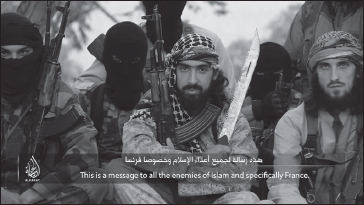
French fighters threaten France in an al-Hayat video.
ISIS CLAIMS RESPONSIBILITY
In video recordings released after the attacks, ISIS claimed responsibility. Using French citizens, they announced, “As long as you keep bombing you will not live in peace. You will even fear traveling to the market.”568
ISIS IN BELGIUM
The Belgian government suggested that there are 180–190 fighters in Syria/Iraq, with as many as 60–70 who have been killed in combat or suicide bombings. As of July 2015, the official government count of Belgians who have returned to the country from Syria/Iraq is 118, but Belgian researcher Pieter Van Ostaeyen estimates that there have been as many as 516 Belgians in ISIS, the highest rate per capita of all recruits in Europe.569
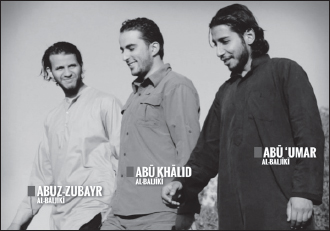
Abdelhamid Abaaoud and his Belgian fighter friends in Dabiq Magazine.
Mehdi Nemmouche, a French national, conducted the May 2014 assault rifle attack on the Jewish Museum of Belgium, killing four before being caught. He was a criminal with four convictions and a prison sentence before leaving for Syria to join ISIS. Nemmouche was said to be one of the ISIS prison guards who tortured hostages. His nickname was Abu Omar the Hitter. He left Syria and returned to France in 2014 to carry out the Brussels attack.
On August 21, 2015, a Belgian of Moroccan origin, Ayoub El Khazzani, boarded the Thalys Eurostar high-speed train with an AKM-variant Kalashnikov, a 9mm Luger pistol, and a knife. He was foiled when three Americans and a British citizen charged him and stopped the potential massacre. It is believed that he was an ISIS-supported operative who planned the attack with Abdelhamid Abaaoud, mastermind of the Paris attack.
Abaaoud was a Belgian citizen of Moroccan origin and resided in Molenbeek. He had spent time in Syria and was a known member of ISIS. He was made famous for a French-language videotape of him dragging the bodies of dead Syrian army soldiers behind a captured Iraqi Humvee. He operated in the Deir Ez-zor combat zone. He may have planned the Paris attacks and acquired weapons in Molenbeek before he was killed by French BRI SWAT officers.
Despite the attack in Paris, Belgium may remain a safe haven for Jihadists returning from Syria and Iraq, especially in the Brussels suburb of Molenbeek. One of Brussel’s nineteen districts, Molenbeek has a population of approximately 100,000, with 30 percent being of foreign nationality and 40 percent having foreign roots.570 Young Muslims in Belgium are antagonized by racism and they have an astronomical rate of unemployment, exceeding 25 percent. The recruiters and radicalizers of ISIS and al-Qaeda play on these grievances and offer them a sense of purpose as well as adventure.
Molenbeek was a logistical and operational hub for ISIS attacks in France and Belgium. After the Paris massacre, Belgium placed the entire country on the highest state of alert and carried out hundreds of raids in an effort to stop what they believed was an imminent threat to carry out an attack in Brussels. Although the pressure was turned on after the Paris attack, it will remain a place where sympathies for ISIS may remain strong.
THE EUROPEAN WEAPONS NETWORK
Since the November 2015 Paris suicide bomb attacks, French police have conducted 2,700 raids, detained 23 people, and put 360 others under house arrest. Two people were also arrested for supplying weapons. One of those two suspects is Claude Hermant, who was arrested in Lille on suspicion of delivering a weapon to Amedy Coulibaly, the al-Qaeda attacker who was killed at the Porte du Vincennes hostage siege during the Charlie Hebdo attacks in 2015.
Unlike the United States, where guns can be purchased legally, or in Belgium, a country that is known as a treasure trove for illegal weapons, in France it’s almost impossible to legally own anything larger than a shotgun or a hunting rifle. The weapons used in most French attacks were military-grade, fully automatic weapons that most likely came to Belgium via or eastern Europe. In 2009 alone, French authorities confiscated over 1,500 illegal weapons. In 2010 that number almost doubled to 2,700 weapons. The Paris-based National Observatory for Delinquency reported that the number of weapons coming into France from warzones and drug smugglers increased two-fold in the last several years.571 In October 2014, raids on several houses in France found large caches of weapons, including machine guns, assault rifles, and pistols. Forty-eight people were detained.572 It was noted that most if not all weapons found on the black market in France and other Western countries were likely acquired from countries where laws are poorly enforced or the weapons are leftovers from conflict zones such as the Libyan revolution or the conflicts in Syria and Iraq. The New York–based nonprofit Foreign Policy Association estimates that there are millions of weapons on the loose with little regulation by foreign government officials.573
Kathie Lynn Austin, an expert on firearms trafficking, remarked that the main reason that many Kalashnikovs make it to the black market is that Russia frequently upgrades its weapons, and obsolete weapons are pilfered or sold in large lots to the black market.574 In the 1990s, before the collapse of the Soviet Union, Russian intelligence would give weapons to radical groups such as France’s Action Directe and the German Red Army Faction, as well as armed militia groups in Bosnia, Serbia, and Kosovo. Even these older weapons find their way into the very lucrative arms market and from there into the hands of ISIS in Europe.
Before its demise, the “dark web” commerce website Silk Road offered many firearms for sale through the Internet, with payment by bitcoin, which makes tracing the sale of illegal guns difficult if not impossible. In some black markets, an AK-47 can cost as little as 700 Euros ($750).575
Belgium is a treasure trove for both dark web and street-level black market purchases. Returning jihadists facilitate the sale of weapons in Europe as a fundraising scheme. The weapons used in the Paris massacres of 2015 came from dealers in Brussels. Claude Moniquet, a former French intelligence officer and co-founder of European Strategic Intelligence and Security Centre, estimated that 90 percent of all weapons flowing into Belgium originated from the Balkans, where smuggling is a living tradition.576
ISIS IN TURKEY
HISTORY
Turkey is on the 900-km frontline of the war with ISIS. Thus far it has not been fully drawn into the fight, but has been in the middle for a while. Despite stated goals of reducing fighter flow to Iraq and Syria, or worse, from Iraq and Syria, Turkey remains a perfect conduit for foreign fighters, money, and materiel. Though there is no stated ISIS wilayat in Turkey, it is safe to say that ISIS has a very powerful presence.
The largest concern in Turkey is the traffic of foreign fighters to Iraq and Syria and the possibility that they will bring the cult of death from Turkey’s doorstep and into its home. Turkey has both deported and denied entry to thousands of people. Additional concerns are the trafficking and availability of weapons, technology, and black market antiquities.
SIGNIFICANT EVENTS
November 29, 2014
Two suicide bombings (SVBIED and PBIED) kill thirty people. Turkey issues a denial that the bombers were Turkish.
December 1, 2014
Turkey allows the United States and coalition forces to use Incirlik air base to strike ISIS in Syria.
December 10, 2014
Turkey reaches an agreement with the UK to stop the flow of foreign fighters and increase intelligence sharing.
January 6, 2015
A married pregnant mother conducts a black-widow attack on an Istanbul police station by detonating the explosive vest she was wearing. One officer is killed. The bomber, Diana Ramazanova was an eighteen-year-old from Dagestan whose husband had been killed in Syria over a month earlier. The two were married after meeting on a dating site.
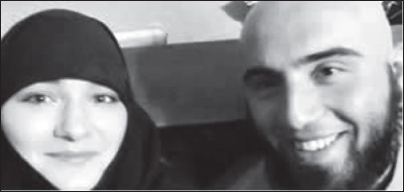
Suicide bomber Diana Ramazanova and her husband.
January 25, 2015
Turkish officials announce the discovery of a cell of operatives sent to Turkey to attack diplomatic missions, including the Belgian, French, and American missions. Intelligence indicated that French national Sufian Yassin led the seventeen-man cell.
February 21, 2015
ISIS threatens to take over Suleyman Shah’s tomb if Turkey does’t give it up. Turkey evacuates the tomb, giving ISIS a victory.
May 2015
Konstantiniyye magazine released as the Turkish-language ISIS propaganda equivalent of the English-language publication Dabiq.
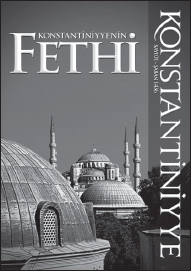
Konstantiniyye, the Turkish equivalent of Dabiq.
July 20, 2015
A young woman self-detonates in the Amara Cultural Center in Suruc, killing thirty and wounding over a hundred more.
July 24, 2015
Turkey launches first attacks on ISIS in Syria, including strikes on al-A’zaz, Tel al-Hawa, and Jarabulus.
August 26, 2015
After ISIS releases an edition of Dabiq discussing the minting of ISIS coins, Turkey seizes coin-making equipment in Gaziantep and arrests six connected with the operation.
August 29, 2015
Turkey strikes ISIS positions again, but this time by operating in the Syrian airspace.
October 10, 2015
Ninety-eight people are killed when two SPBIEDs detonate during a peace rally in Ankara.
November 24, 2015
Turkey shoots down Russian Sukhoi-24 along the border with Syria.
ISIS suicide bomber from Saudi Arabia blows up in the Sultan Ahmet district near an ancient Egyptian obelisk, killing nine German tourists and a Peruvian.
ISIS IN THE CAUCASUS
HISTORY
During the 1995 war against the Russian Federation thousands of foreign fighters from dozens of Islamic extremist groups fought to establish an independent Islamic Republic of Chechnya. There was heavy involvement of educated, Western “vacation jihadists,” principally from the United Kingdom, along with a nascent propaganda effort through audio tapes, video, pamphlets, and books produced in the West. The practice of videotaping the decapitation executions of Russian soldiers began during the war in Chechnya. The Russian military forces finally enforced order on the breakaway republic with scorched-earth policies. Highly sophisticated Islamic-oriented Chechen militants departed in the region of Chechnya, Dagestan, and Ingushetia, and traveled down to Iraq and Syria.
Tarkhan Tayumurazovich Batirashvilli, a.k.a. Abu Omar al-Shishani, a.k.a. Omar the Chechen, was a sergeant in the Georgian Army who is now Emir of Northern Syria. He commands a force nearing one thousand strong and commands fear and respect.
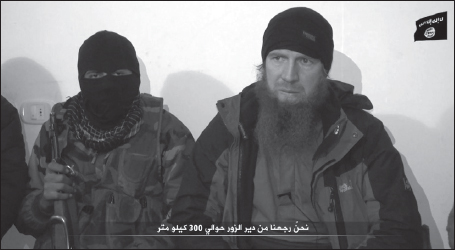
Tarkhan Tayumurazovich Batirashvilli, a.k.a. Abu Omar al-Shishani, the Emir of Northern Syria.
The al-Qaeda–linked Islamic Caucasus Emirate (ICE) has been the primary jihad group in the area, but with the deaths of several top leaders, and the defections of several others, is losing ground to ISIS.577 As many as two thousand Russian citizens have joined ISIS’s war in Syria, according to the Deputy Secretary of the Russian Security Council, but other sources indicate that the number may be as high as five thousand.578, 579
Chechens also have a notable presence in the Russian black market and for involvement with organized crime in Russia and internationally.
CAUCASUS OATH OF ALLEGIANCE
On June 27, 2015, the Caucusus province issued its oath of allegiance to Abu Bakr al-Baghdadi. “Obeying the order of Allah, we are declaring our allegiance to Caliph Ibrahim ben Awwad ben Ibrahim al Badri al-Qoureishi al Husseini for obedience and subordination… We testify that all mujahideen of the Caucasus are united in this decision, and there are no disagreements among us on this issue.”580
ORGANIZATION OF ISIS IN THE CAUCASES
Little is known of any formal organization by ISIS in the Caucasus region, other than that Abu Bakr al-Baghdadi conferred the title of Emir on Abu Muhammad al-Qadri for the United Wilayat of Kabarda, Balkaria, and Karachay.581 Qadri may be Rustam Asilderov, who defected from ICE.
OTHER SIGNIFICANT EVENTS
September 3, 2014
ISIS releases a video depicting captured Syrian aircraft, made in Syria, with a threat to deploy them against Russia and to liberate Chechnya.582 ISIS states the intention of including Chechnya and the Caucasus in the Caliphate.
October 2014
In a wiretapped phone conversation with his father, Omar al-Shishani says that ISIS will invade Russia.583
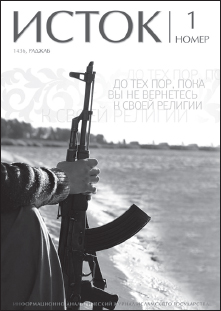
Istok, the Russian language version of Dabiq, is released in May 2015.
ISIS propaganda department al-Hayat, publisher of Dabiq, publishes a twenty-four-page Russian- language magazine called Istok (“outflow” or “origin”). One reference inside says that the writers of the magazine “have been fighting in the Caucasus against Russian tyrants.”584
June 18, 2015
CIS Anti-Terrorist Center chief Andrei Novikov reports confirmed documentation that up to five thousand Russian Federation citizens are fighting for ISIS.585
June 27, 2015
ISIS spokesman Abu Mohammad al-Adnan issues an audio recording stating that Abu Bakr al-Baghdadi has accepted a pledge of allegiance by Caucasus jihadis, and that Abu Muhammad al-Qadri is the Emir of the United Wilayat of Kabarda, Balkaria, and Karachay.586
August 2, 2015
Russian FSB forces conduct a raid in a forest of the Sunzha district of Ingushetia, killing eight ISIS supporters. The FSB found a cache of assault weapons, grenades, IEDs, and ammunition.587
September 2, 2015
ISIS Caucasus claims responsibility for an attack on a Russian military barracks in Magharamakint, Dagestan.588
November 29, 2015
Three ISIS-affiliated militants killed by a special counterterrorism detachment of Russia’s Federal Security Service (FSB) in Dagestan. One of the fighters had recently returned from Syria.589
WEAPONS AND EQUIPMENT ORDER OF BATTLE
With the apparent control of Russia over the Caucasus region, fighters from the region appear to be going to the conflict in Syria and Iraq, rather than staging another war against Russia. Attacks thus far have been distinctive hit-and-run ambush tactics with the same materiel used during the war, including Russian-made small arms, assault rifles, and RPGs. They also employ grenades and homemade bombs.590 Chechen militants would sometimes capture and use military vehicles but preferred to destroy them.
ISIS IN CANADA
The ISIS presence in Canada appears to be minimal, and has thus far demonstrated a few inspirational attacks. There are no known ISIS groups or cells.
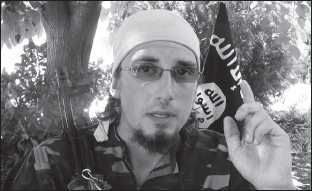
Canadian Andre Poulin under nom de guerre “Abu Muslim” in the al-Hayat video, “Al-Ghuraba: The Chosen Few of Different Lands.”
SIGNIFICANT EVENTS
October 20, 2014
At 11:30 a.m. in Saint-Jean-sur-Richelieu, Quebec, twenty-five-year-old Martin Couture-Rouleau ran his car into two officers in an insurance company parking lot. Police engaged in a chase, during which Couture-Rouleau called 911 to declare that his actions were taken in the name of Allah. Couture-Rouleau lost control of his car during the chase and flipped upside down into a ditch. He then exited the car and attempted to attack a police woman. When he charged toward her, he was shot to death by officers. In the end, one Canadian Army soldier, warrant officer Patrice Vincent, fifty-three, was killed. The twenty-eight-year veteran had planned to retire.
Couture-Rouleau was known to the RCMP due to Internet postings and from relatives who had seen a personality shift since converting to Islam a year before. He was living with his parents. He changed his name to Ahmad LeConverti and often posted Qur’an verses on Facebook. His passport had been seized.591
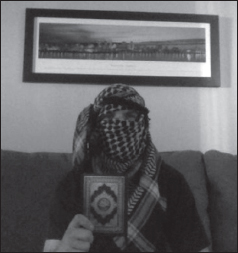
Canadian Martin Couture-Rouleau, the 2014 Saint-Jean-sur-Richelieu attacker.
October 22, 2014
At 9:52 a.m. at Parliament Hill in Ottowa, Michael Zehaf-Bibeau killed Corporal Nathan Cirillo, who was working as a sentry for the Canadian National War Memorial. Zehaf-Bibeau was shot by officers after he went to the Canadian Parliament building and engaged in a shootout with security, injuring three responding officers.592
The thirty-two-year old Libyan-Canadian from Montreal was considered mentally ill by his mother. She claimed he felt trapped by officials because his passport was being held. Despite earlier statements that he had intended to travel to Syria, he was intending to travel to Saudi Arabia. His mother also stated that he had been a severe drug addict.593
ISIS IN THE UNITED STATES
ISIS’s activities in North America have been limited to aspirational attacks at most. No organized ISIS cells have conducted a major operation in America yet. There are currently dozens of cases before the Department of Justice of Americans who have either engaged in support or sought to engage support for ISIS. By the end of 2015, there were nine hundred active investigations throughout all fifty states, according to the FBI. Additionally, seventy-one cases are in the judicial system for individuals who have been charged with ISIS-related crimes.594 No groups have sworn allegiance to ISIS.
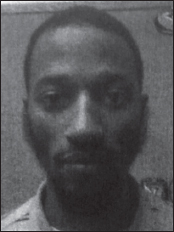
Mugshot of Garland, Texas shooting suspect Elton Simpson.
Garland, Texas: At an event dubbed the “First Annual Muhammad Art Exhibit and Contest,” held at the Curtis Culwell Center, an arena and conference center in Garland, Texas, two gunmen attacked after getting out of a black sedan. They began shooting at police officers, who were guarding the event and had established a perimeter. The assailants wore body armor, carried assault rifles, and used the car as cover while shooting at the police officers. In less than twenty seconds, police killed both attackers, who were later identified as Elton Simpson and Nadir Soofi.595
The roommates had driven from Phoenix, Arizona. Soofi had a carpet cleaning business in Phoenix. The Texas native was born to a Pakistani father and American mother, and was raised as a Muslim. After his parents divorced he lived in Pakistan for six years, then returned to the US. The college dropout had a list of over twenty offenses on record and a failed pizza business that had just closed down months before.596 His mother said Elton Simpson had indoctrinated her son.
Thirty-year old Elton Simpson had been engaging in contacts with ISIS members before the attack. Having converted to Islam in high school, the FBI first took note of him in 2007 after tracking the activities of Phoenix-area resident Hassan Abujihaad, a former Navy sailor who had been convicted on terror charges. Both had attended the Islamic Community Center of Phoenix.597
Simpson had been under investigation for years, with over 1,500 hours of secret recordings with an FBI informant. In those conversations he states, “I’m telling you man, we can make it to the battlefield.” He was later charged for lying about his plans to travel to Somalia. During trial the recordings of his conversations were played and he said, “If you get shot, or you get killed, it’s straightaway [to heaven]. That’s what we’re here for, so why not take that route?”598
Simpson also actively contacted the British pro-ISIS hacker from the CyberCaliphate, Junaid Hussain, a.k.a. Abu Hussain al-Britani, via Twitter direct messages. He also was in contact with Minnesota resident Muhammad Abdullahi Hassan, who was a known recruiter for the jihad militant group al-Shabaab. Days before the attacks, Simpson tweeted about the Garland, Texas event with the question, “When will they ever learn?” Junaid Hussain then called on Simpson to “do their part” in a tweet response.599 Simpson posted a tweet just before the attack reading, “May Allah accept us as mujahideen,” which Junaid Hussain subsequently re-tweeted.
A third suspect, Abdul Kareem, a.k.a. Decarus Lowell Thomas from Philadelphia, was charged with conspiracy, false statements, and transport of firearms after allegedly supplying the attackers with weapons and ammunition.600
DECEMBER 2015
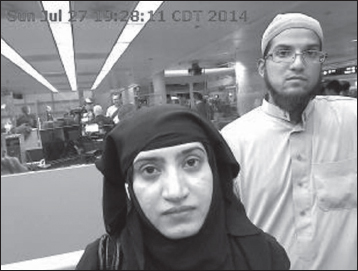
San Bernardino, California:Two American Muslims, American-born Sayed Farook and his Pakistani-born wife Tashfeen Malik, plotted and carried out a mass shooting at the Inland Regional Center, a social services center supporting the disabled in San Bernardino, killing fourteen people. Armed with AR-15 rifles, handguns and homemade pipe bombs they entered a Christmas party for staff and disabled in the office where Farook used to work. Before entering, Tashfee Malik left their six-month-old child with her husband’s mother. She then posted a loyalty oath to ISIS on social media, just moments before committing the attack. The couple, dressed all in black, then entered the office party and shot 65–75 rounds of .223 rifle ammunition, killing fourteen and wounding twenty-two others. They left behind three pipe bombs wired to a remote detonator that failed to explode. The pair managed to elude a hasty police perimeter and return to their residence for eighteen minutes when surveillance officers saw them depart for an undetermined destination. Fearing they were enroute to another targets the police attempted to stop them. Tashfeen Malik engaged them with an AR-15 rifle from the backseat of the rented SUV while Farook drove. They were both killed in a fusillade of gunfire from a wide variety of police and SWAT officers. Both Farook and Malik were radicalized over some period of time and may have had similar beliefs when they met in Saudi Arabia. They successfully hid their intentions from their family, with the exception of a brother-in-law, Enrique Marquez, Jr., who discussed plots for both an attack on a regional university and a mass shooting on a highway.601 ISIS praised the attack in their online magazine Dabiq 13 but did not take credit for the incident. They showed a photo of Farook and referred to him as a “Mujahid” or holy warrior:
“As the operation took place, Tashfeen Malik made a post online reaffirming their bay’ah to Amīrul-Mu’minīn, Shaykh Abū Bakr al-Baghdādī (hafidhahullāh). She and her husband then engaged in a shootout with security forces and were killed, thereby attaining shahādah in the path of Allah. We consider them so, and Allah is their judge. Thus, the Khilāfah’s call for the Muslims to strike the crusaders in their own lands was answered once more, but on this particular occasion the attack was unique. The mujāhid involved did not suffice with embarking upon the noble path of jihād alone. Rather, he conducted the operation together with his wife, with the two thereby aiding one another in righteousness and taqwā.”602
ISIS IN AUSTRALIA
No known organizations in Australia have sworn bayat to ISIS. However, numerous Australians have joined and radicalized individuals carried out two noteworthy events. Cameron Gifford, the assistant secretary of the National Security Law and Policy Division of the Australian Federal Police, noted that around 120 Australians are engaged in fighting in Syria/Iraq, that somewhere between 32–42 have been killed in combat or suicide bombings, that approximately 30 Australians have returned home, and that 170 people are providing material support.
Self-radicalization is the most emerging threat in Australia, followed by returning jihadis who inspire or plan attacks. Australia has suffered disproportionately from terrorist attacks.
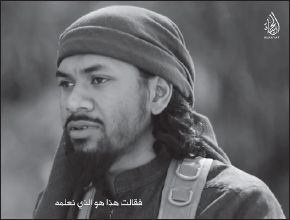
Australian Abu Khaled al-Cambodi featured in an al-Hayat video.
SIGNIFICANT EVENTS
September 2014
Endeavor Hills stabbings: Eighteen-year-old Abdul Numan Haider stabbed an officer from the Joint Counter Terrorism team after arriving at the police station in Melbourne’s Endeavor Hills suburb. Haider was already known to authorities from previous threats against Tony Abbott, the Australian prime minister at that time.603 Haider’s parents migrated to Australia from Afghanistan around 2004. Authorities had previously visited with his family. He had been monitored by authorities for months and had planned to behead police officers.604 He was carrying the ISIS shahada flag when he stabbed the officer. He was shot dead with one round.
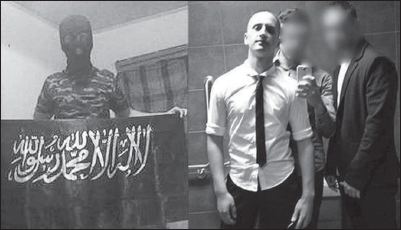
Australian Abdul Numan Haider posing for ISIS.
December 2014
Sydney Hostage Crisis: Early on December 15, 2014, Man Haron Monis took eighteen people hostage—eight staff and ten customers—at the Lindt Café in Sydney. The siege lasted sixteen hours and played out on national and international television, since it occurred directly across the street from the Seven Network studio.605 Armed with a shotgun, Monis ordered to the hostages to hold up a black shahada flag. He claimed to have planted bombs around Sydney and ordered a hostage to tell the news media that “This is an attack by the Islamic State.”
In the afternoon, five hostages managed to escape. Around 2:14 a.m., the Tactical Operations Unit stormed the cafe using stun grenade and M4A1 carbines.606 In the end, two hostages died. Tori Johnson, manager of the café, was shot by Monis when he tried to take his gun, and employee Katrina Dawson was killed by police bullets.607 Three other hostages were wounded during the raid by police gunfire. Monis was killed by officers during raid. Monis had a complex psychological pathology; he was diagnosed as schizophrenic by his doctors, and claimed to be a vast range of different characters, from a member of the Iranian intelligence services to a faith healer. While protesting at Parliament House, he called himself “Ayatollah Manteghi Boroujerdi.”608